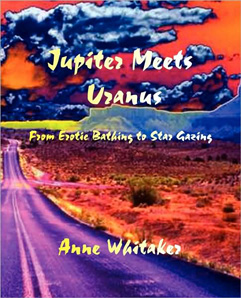Jupiter
Meets Uranus
Book
Review:
Jupiter Meets Uranus,
by Anne Whitaker, pub. by American Federation of Astrologers, 2009
--
click to e-order
at Amazon
Reviewed by John Townley
As the somewhat-scary Jupiter-Uranus conjunction prepares to burn its
way across the sky -- scary in part because it's involved in a huge
cardinal T-cross (and occasional grand cross) involving Pluto and
Saturn, and bringing in Moon, Venus, and Mars by August 2010) -- it
would probably be a good thing to attend to what this might mean. The
place to go to do that would be this uniquely-researched book which is
not only the sole book I know of devoted only to this subject, but the
result of a dedicated research project intended to dig out the most of
of what it might mean, especially personally.
Jupiter conjoins Uranus roughly every fourteen years, so it's one of
the primary long-scale joint planetary rhythms, combining the expansive
and (usually) positive effects of the biggest benefic with the instant
and often cart-toppling energy of the first-discovered outer planet,
whose strangeness only begins with the fact that its poles are where
its equator should be. Further, the two are linked in a fairly close
7:1 orbital resonance (one revolution of Uranus equals seven of
Jupiter), which means that every seventh conjunction is near the same
place for about five repetitions over a period of 400 years. Recently,
that has meant that the sometimes violently portentious entrance of
Uranus into Aries has been kicked up a notch by Jupiter for the last
three (in 1762, 1845 and 1927), this year's, and finally the next in
2094. We've been in it's most aggressive manifestation for some time.
So what does it all mean? Whitaker opens with the overview of where and
how often it occurs by sign and element from 500 BC to the present,
with some speculation as to coincident periods of civilization
development along the way, ranging from voyages of discovery to
politics, to music and literature, quoting the likes of Tarnas and
Harvey along the way, and unfortunately sharing their (and most other
astrologers') error of looking only at the development of Western
civilization. Wasn't something relevant happening in India (which uses
sidereal signs) and China (whose years are based on the Jupiter cycle)?
It would be nice to know. And, following in line with Tarnas and
others, the interpretations of the effects of both Jupiter and Uranus
retain their meanings traditional to individual horoscopes of
short-lived human beings, while being applied to superorganisms like
nations and cultures, which have very different timescales, and where
the relative motions of slower planets may mean something else
entirely. If you want an amusing example of how this might (indeed,
must) be adjusted for, you have only to look here.
But another set of speculations on what big cycles might be about is
not, in fact, what this book is about. It's something far better, right
down here on the human scale. It originated as a journalistic and (dare
we say) somewhat scientific approach to document what the effects of a
Jupiter-Uranus conjunction might be, from beginning to end, in the
lives of individuals and chronicled by the individuals themselves.
Whitaker asked seventeen people to take personal notes all through the
last conjunction of Jupiter and Uranus (in Aquarius in 1997) and then
follows through with their experiences and their individual charts to
come out with a more intimate and variegated experience of the
conjunction (some dropped out, but over half remained throughout). In
spirit, it mimics the famous Framingham heart study,
and as
such it's an original and welcome breath of fresh air. There has never
been a predesigned longitudinal astrological study that I know of, and
this is as close as it comes, appropriately from the country that
pioneered early, rigorous medical studies of this ilk.
As the variations on the 1997 conjunction proceed, Whitaker follows
each participant's chart as individual planets are hit, the retrograde
and direct periods sweep them, and she plumbs their overall impressions
of the period and how it changed their lives, particularly those with
planets in the 5-6 degree area of Aquarius conjunction. Follow-ups are
included all the way through 2001. One wonders if by chance
(or
natural happenstance) that area is highlighted in the author's chart
(if she mentioned it, I missed it). That would certainly add
dimension. And, one hopes that she will take the opportunity
of
this new Jupiter-Uranus conjunction to both follow up on her previous
subjects and collect a new batch to replicate the experiment. (Note:
you can follow and
participate in just such developments and lots more on her Jupiter
Meets Uranus website.)
However you look at it, this is a most timely book to have right now,
so hats off to Anne Whitaker for creating an astrological classic that
forges a new template for further astrological research and
inquiry, and which introduces both the approaches of
journalistic
reportage and scientific experimentation and follow-up...
|
|
|

click
here
to buy this book

Anne
Whitaker researches the sky
from the particularly advantageous
northern exposure of Scotland, where the muses of Islay single malts
breathe spirit into her insights..you can find her latest commentary
and
blogs at Writing from the
twelfth house...
|


